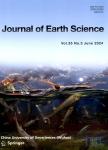Movement History of the Microcontinents from the Tibetan Plateau Based on Paleomagnetic Results with Sufficient Sampling Units
Movement History of the Microcontinents from the Tibetan Plateau Based on Paleomagnetic Results with Sufficient Sampling Units作者机构:School of Earth SciencesChina University of GeosciencesWuhan 430074China College of Earth SciencesGuilin University of TechnologyGuilin 541004China State Key Laboratory of Biogeology and Environmental GeologyChina University of GeosciencesBeijing 100083China
出 版 物:《Journal of Earth Science》 (地球科学学刊(英文版))
年 卷 期:2022年第33卷第5期
页 面:1072-1080页
核心收录:
学科分类:070904[理学-构造地质学] 070801[理学-固体地球物理学] 0709[理学-地质学] 07[理学] 0708[理学-地球物理学]
基 金:supported by the National Natural Science Foundation of China(Nos.41802242 and 42174089)
主 题:paleolatitude evolution Fisher mean random sampling sampling sites and samples continental collision tectonics
摘 要:Paleomagnetic results cannot be applied in global and regional tectonic reconstructions unless the paleosecular variation has been adequately ***,how many sampling sites and samples are enough to calculate a reliable paleopole remains *** on the relation among the sampling sites N,the precision parameter k,the virtual geomagnetic pole scatter s,and the confidence limit A_(95) of the paleopole,we find that 20 sites(samples)or more are required to yield a paleopole with an A_(95)≈5°based on a review of available paleomagnetic results from the Lhasa,Qiangtang and Tethyan *** samplings of Jurassic virtual geomagnetic poles from the Sangri area show that the Fisher mean pole with neglectable angle deviation can be obtained when sampling sites increase to ***-quality paleomagnetic results,with sites/samples number N/n≥~20–30,show that the Qiangtang,Lhasa,and Tethyan Himalaya moved northward in the Late Permian–Middle Triassic,Jurassic,and Cretaceous,respectively,and then accreted to Asia in the Late Triassic,Late Jurassic–Early Cretaceous and Paleocene–Early Eocene,respectively.



